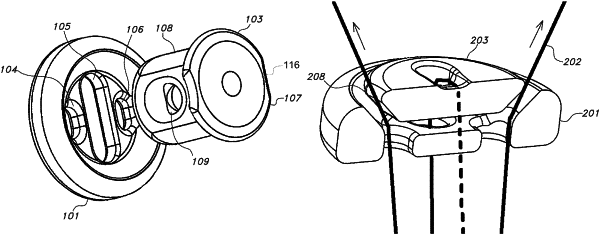| CPC A61B 17/0487 (2013.01) [A61B 17/0401 (2013.01); A61B 2017/0404 (2013.01); A61B 2017/0409 (2013.01); A61B 2017/0417 (2013.01); A61B 2017/0451 (2013.01); A61B 2017/0495 (2013.01); A61B 2017/0496 (2013.01); A61B 2090/061 (2016.02); A61B 2090/062 (2016.02)] | 20 Claims |

|
1. A button-suture assembly to fix tissue to tissue, bone, or other member, comprising:
a suspension device defining a first end and comprising a button and a locking pin, the button having a proximal facing surface, a distal facing surface configured to mate or fix to tissue, bone, or other member, a receiving surface configured to mate with the locking pin, and first and second lateral openings positioned on opposite sides of a central opening, the locking pin having a mating surface configured to mate with the receiving surface of the button;
at least one suture interacting with the suspension device, the at least one suture having a proximal end portion extending proximally from the suspension device, the at least one suture passing through the suspension device and forming a first loop portion extending distally from the suspension device, the first loop portion defining a second end configured to mate with tissue, bone, or other member, the at least one suture passing through the suspension device between the receiving surface of the button and the mating surface of the locking pin;
wherein the button-suture assembly comprises a first state defining a first distance between the first and second ends and second state defining a second distance between the first and second ends, the second distance being less than the first distance;
wherein the proximal end portion of the at least one suture comprises first and second suture ends, the first and second suture ends passing through the first and second lateral openings, respectively, immediately before passing between the receiving surface of the button and the mating surface of the locking pin; and
wherein the proximal end portion of the suture is configured to be pulled taut in the proximal direction when the first end of the button-suture assembly is mated with a first tissue and the second end of the button-suture assembly is mated with a second tissue, bone, or other member, thereby creating tension in the suture which causes the button-suture assembly to transition from the first state to the second state, where the second state is maintained via compression and friction applied to the suture between the receiving surface of the button and the mating surface of the locking pin.
|